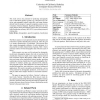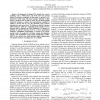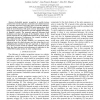255 search results - page 15 / 51 » On the use of speaker superfactors for speaker recognition |
TASLP
2002
13 years 7 months ago
2002
This paper presents a framework for maximum a posteriori (MAP) speaker adaptation of state duration distributions in hidden Markov models (HMM). Four key issues of MAP estimation, ...
INTERSPEECH
2010
13 years 2 months ago
2010
This work surveys the potential for predicting demographic traits of individual speakers (gender, age, education level, ethnicity, and geographic region) using only word usage fea...
ICASSP
2011
IEEE
12 years 11 months ago
2011
IEEE
—Discriminative Training (DT) methods for acoustic modeling, such as MMI, MCE, and SVM, have been proved effective in speaker recognition. In this paper we propose a DT method fo...
ICASSP
2011
IEEE
12 years 11 months ago
2011
IEEE
This study seeks to quantify the effectiveness of a broad range of acoustic features for speaker identification and their impact in feature fusion. Sixteen different acoustic feat...
MMSP
2008
IEEE
14 years 1 months ago
2008
IEEE
—Embedded speaker recognition in mobile devices could involve several ergonomic constraints and a limited amount of computing resources. Even if they have proved their efficienc...



